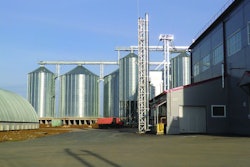
Charles Starkey of Auburn University explains the many ways feed mills can cut down on the risk of viruses, bacteria and other microbes in feed
Feed mills encounter a lot of risks for bacteria, viruses and other microbes, but they also have many points along their processes where they can minimize those risks by implementing good biosecurity practices, according to Charles Starkey, assistant professor of poultry science at Auburn University.
Starkey spoke March 16 at USPOULTRY’s Feed Mill Management Seminar in Nashville, Tennessee.
“Everything has to do with biosecurity. There’s so many ways that bacteria, viruses and other things can enter our facility. And then what do we do? We mix it up in a big old mixer and we send it to every farm we have,” he said.
And because some contaminants such as Salmonella are so easily spread, it is important to minimize the ways they can spread.
“Salmonella is ubiquitous. It’s everywhere,” he said. “We’ve all got it on us today. You’re not going to get rid of it.”
That’s why he said feed mills should use good biosecurity all the way through their processes.
“We’ve got to prevent contamination initially, and we’ve got to prevent recontamination,” he said.
There are many tools for improving biosecurity, Starkey said, including the following.
- Only allow employee access: With multiple people coming and going, there is more potential for spreading microbes. Don’t let drivers, contractors or other non-employee visitors move freely about your facility.
- Air filtration and dust control: Good air filtration and dust control means a cleaner facility.
- Pest control: Consider using a commercial pest control company, as many feed mills do. Even having pets such as cats or dogs in the feed mill can contribute to disease spread.
- Monitor quality and supply, field handling and storage of ingredients: Know what contaminants your supplier is screening for. Understand the potential contamination due to the way ingredients are handled or stored before they get to your feed mill.
- Identify all potential microbial hazards: Know what hazards are important for the species you’re serving.
- Fencing, locks and access control: While fencing is not required by regulations, it keeps out pests and people who shouldn’t be on the property and could contaminate feed.
- Lights and cameras: Train employees how to use and access cameras to improve monitoring and security.
- Employee training: Make sure your employees know that if they see someone they don’t know on your facility’s property, they need to direct them to the office and have them sign in. Use sign-in books religiously because having a record of who has been in your facility and when is important especially in the event of a disease outbreak or recall.
- Talk with local law enforcement: Have a good relationship with local law enforcement officers and explain feed biosecurity to them and why it is important. Let them know what types of suspicious activity to look out for at your facility.
- Truck sanitation: Drive-through spray cleaners can help keep trucks clean before they enter your facility and minimize the risk of microbial spread from farm to farm.















